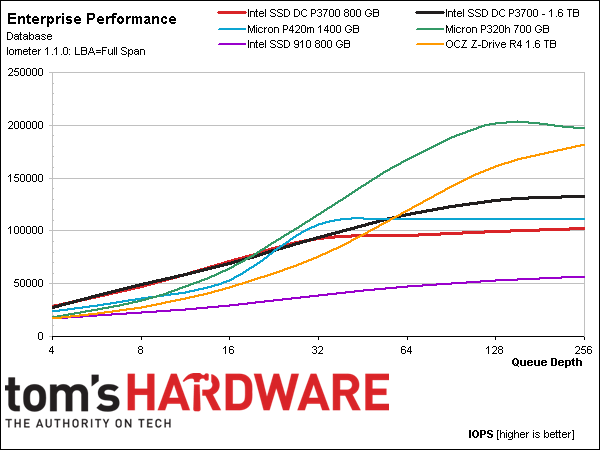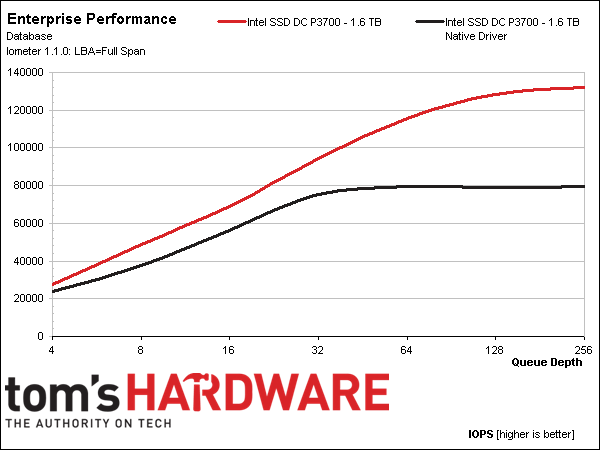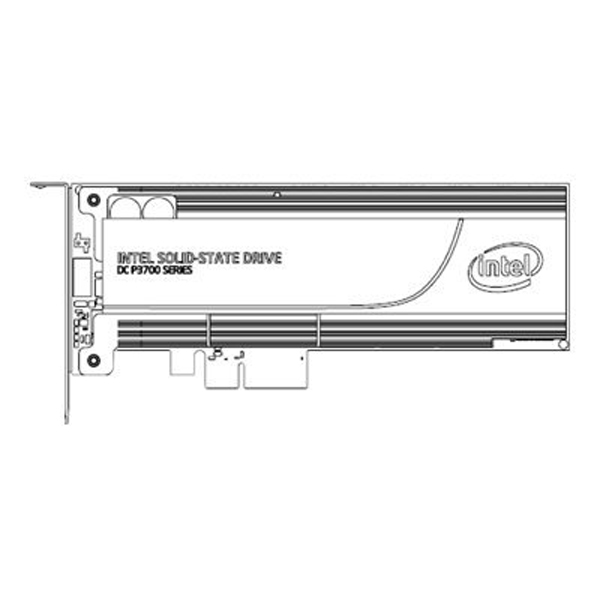Intel SSD DC P3700 800GB and 1.6TB Review: The Future of Storage
With the introduction of its SSD DC P3700, P3600, and P3500, Intel is giving us our first taste of the PCIe-based NVMe specification. We take the flagship P3700 for a drive in its 800 GB and 1.6 TB incarnations. Just how fast is the future of storage?
Results: Enterprise Workload Performance
Our next set of tests simulates different enterprise-oriented workloads, including database, file server, Web server, and workstation configurations.
The database workload (also categorized as transaction processing) involves purely random I/O. Its profile consists of 67% reads and 33% writes using 8 KB transfers.
The SSD DC P3700's excellent performance at low queue depths shows through in our database profile. As the command queue increases, Micron's P320h and OCZ's Z-Drive show their respective strengths.
Even though we didn't measure much difference between Intel's proprietary driver and Windows' native support in our performance consistency test, that's not the case here. Intel's more optimized implementation typically yields a 5-10% boost at low queue depths, which increases to 20-25% as commands started stacking up. Even though the native driver lets you boot to Windows and get started quickly, you really should make sure Intel's software gets installed before taxing the SSD DC P3700 in a production environment.
In the file server workload, which consists of 80% random reads of varying transfer sizes, we see similar results. The SSD DC P3700 again does an excellent job at low queue depth, and both capacities stay ahead of Micron's P420m.
Our Web server profile closely mirrors our random 4 KB read tests, which makes sense: it's 100% reads of varying transfer sizes.
While the finishing order is close at low queue depths, Micron's drives pull away beyond 32 outstanding commands. The two SSD DC P3700s behave almost identically due to their similar read performance.
Get Tom's Hardware's best news and in-depth reviews, straight to your inbox.
Lastly, the workstation benchmark (80% reads, 80% random) results land predictably in our chart as the SSD DC P3700 drops off at higher queue depths.
Summing it all up, Intel's latest performs well at low queue depths and then trails as the count increases. Also, compared to Micron's P420m, the SSD DC P3700 performs better as the workload biases to writes. Unfortunately for Intel, the P3700s can't touch the Micron drives in read performance.
Current page: Results: Enterprise Workload Performance
Prev Page Results: Sequential Performance Next Page Results: Enterprise Video Streaming Performance-
xback In the 1st table on page 1, the "4k random write IOPS" are reversed :)Reply
(3500 scores highest, while the 3700 scores lowest) -
redgarl OCZ already went there and even made their own connector for providing more bandwith to SSD... just a shame that now Intel try to remove the carpet from beneath the feet of OCZ. Well, old tech is new tech.Reply
By the way, OCZ revodrive was priced similarly, I don't see that big fuzz from Toms here. -
Nuckles_56 "Intel's 2 TB model purportedly needs 650 LFM across the drive"Reply
What the hell is LFM? -
JeanLuc The active power consumption numbers on first table are wrong (I hope!) 35,000 watts active?Reply
Edit:
It's not actually wrong it might just be my out of date browser I'm using in the office but for me the numbers aren't lining up correctly. -
pjmelect Reply"Intel's 2 TB model purportedly needs 650 LFM across the drive"
What the hell is LFM?
Linear Feet per Minute of airflow
-
pjmelect Reply"Intel's 2 TB model purportedly needs 650 LFM across the drive"
What the hell is LFM?
Linear Feet per Minute of airflow
-
Nuckles_56 Reply13947314 said:"Intel's 2 TB model purportedly needs 650 LFM across the drive"
What the hell is LFM?
Linear Feet per Minute of airflow
Ah that makes sense now





